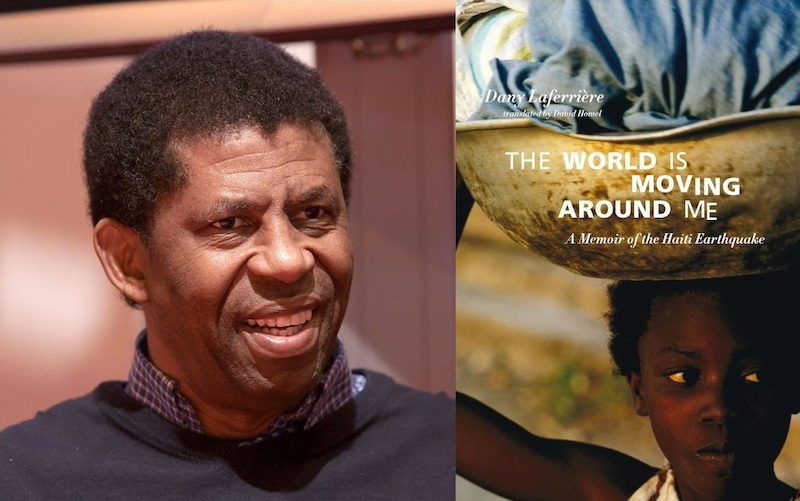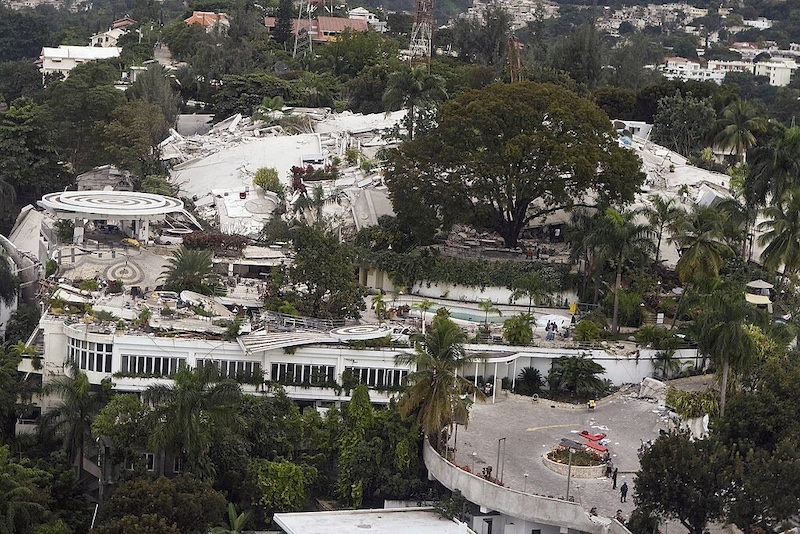Why Write? In Haiti, an Author Makes Sense of Disaster
Posted on April 09, 2024

“I’d like to write something about this . . .”
So says the nephew of author Dany Laferrière in his memoir "The World is Moving Around Me" (translated by David Homel), a personal account of the devastating 2010 earthquake in Haiti. Laferrière was visiting Haiti from his home in Canada when the quake took place. In this excerpt, Laferrière and his nephew sit together, assessing the damage after the earthquake has torn through the capital city of Port-au-Prince.
Laferrière is heartened by his nephew’s impulse to tell his own story, but the boy has an odd request for his uncle: “I’d like you not to write about it.” The earthquake, he explains, is the event that will mark his generation forever, whereas Laferrière’s generation is better suited to write about past events like the Duvalier dictatorship.
The nephew’s comment raises several important questions for Laferrière, which he explores through a series of vignettes: Who gets to “claim” an event by writing about it? Could one perspective possibly capture something as enormous as an earthquake? And finally, what can writing (or, more broadly, art) do in the wake of such destruction and devastation?
As the author navigates through post-quake Port-au-Prince—mourning the loss of dear friends; wading through spilled wine in a convenience store, where the shopkeeper is making do without electricity; watching street artists rehang their canvases—he starts to piece together an answer to the question of “why write?”:
When everything else collapses, culture remains. The people who are still moving will save this city. The crowd’s appetite for life makes living possible in these dusty streets.
When Laferrière returns to his half-demolished hotel, he finds his room and his computer miraculously intact, just as he left them—as if the universe were urging him to keep moving, to put his experience on paper.
Contextualizing “The World is Moving Around Me”

To give students context for the memoir, you can have them do some research into the 2010 earthquake. You might point them to the following resources:
- Read coverage of the earthquake in the Guardian.
- Then, see the photo from Ivanoh Demers (the photographer who appears in this piece) “of the young boy lifting his eyes to us with a mixture of pain and gravitas” on the cover of TIME magazine in January 2010. See more of his photos and read his reflections on the earthquake a decade later on Radio-Canada.
- Speak French? Read “Soudain, Le Chaos,” (“suddenly, chaos”), an article from Chantal Guy, the journalist from La Presse in Montreal who was in Port-au-Prince with Laferrière during the earthquake. (Or, use Google’s auto-translate function to read the article in English.)
Or, students might read or watch firsthand accounts of the earthquake to get a more complete picture of the event:
- Just after the quake, many people in Haiti took to Twitter to spread the news. Read some of those tweets in the Guardian.
- Watch an Al Jazeera news report interviewing a woman who survived the earthquake with her infant daughter.
After reading and watching these stories, you might ask students:
- Why is it important to record stories like these?
- What can they offer us that journalism and news reports cannot?
Connecting these sources back to the story, you might also ask:
- Do you agree with the author’s nephew when he says that young people like himself should be the ones to write about the earthquake?
- Who do you think should get to write about these events, and why?
Laferrière offers a possible answer to the first set of questions in a 2016 interview with Words Without Borders:
It was also important that someone who knew the people—who knew the people before the earthquake—could write about them. Otherwise, as we have seen in the media around the world, all that is spoken of is the dead, the wounded, the fallen houses, but not the people.
He goes on to say:
We don’t see the people in those stories because most of the journalists who came to Haiti were not journalists who had spent time in Haiti. All they knew was what they had seen of the event. So what could they say of the actual people of Haiti—about what they were thinking? About how they lived? They could only say, “Haiti is a poor country and something bad has happened.” But I witnessed the event, and I knew the people who were there on the ground. They were human beings who had a life, who had a lineage, who had parents, who had children, who had lives. They were not poor or rich. They were people and these people had humanity.
With Laferrière’s comments in mind, you may also choose to show students some images that humanize Haiti and give them a sense of the country beyond the earthquake. We recommend the photo series "Haiti Beyond the Headlines," published in the Columbia Journal and set to music in the video below.
Potential Assignments
- Essay: What world event do you consider to be the defining event of your generation so far? Why? How has it shaped you? (For example, earlier generations might choose events like 9/11, the fall of the Soviet Union, or the Kennedy assassination. Younger students might choose events like the COVID-19 pandemic or the election of a particular world leader.)
- Oral history: Interview someone older than you (perhaps a parent, grandparent, neighbor, or family friend) about an important world event. Where were they when it happened? How did it make them feel? What changed in the aftermath of the event? Challenge: Choose a recent world event as the subject of discussion with your interviewee. After you’ve conducted your interview, compare your thoughts about the event to those of your interview subject. How do your experiences differ? How are they the same?
Pairs Well With . . .
Read more literature about the Haiti earthquake on Words Without Borders:
- "Primal Needs," by Évelyne Trouillot, in which a wealthy young man and a servant forge an unlikely connection
- "Port-au-Prince on an IV Drip," by Louis-Philippe Dalembert, a poem that plays with sound to describe Port-au-Prince after the quake
Or, read more literature about generation-defining events on WWB Campus:
- "An Interview with Wu Wenjian," by Liao Yiwu, a conversation with a painter who was imprisoned after the 1989 Tiananmen Square protests in China
- "The Wondrous Deer of the Eternal Hunt," by Svetlana Alexievich, an oral history featuring a widow whose husband was imprisoned in Stalin’s gulag
By Maggie Vlietstra



